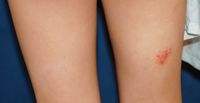- Case-Based Roundtable
- General Dermatology
- Eczema
- Chronic Hand Eczema
- Alopecia
- Aesthetics
- Vitiligo
- COVID-19
- Actinic Keratosis
- Precision Medicine and Biologics
- Rare Disease
- Wound Care
- Rosacea
- Psoriasis
- Psoriatic Arthritis
- Atopic Dermatitis
- Melasma
- NP and PA
- Skin Cancer
- Hidradenitis Suppurativa
- Drug Watch
- Pigmentary Disorders
- Acne
- Pediatric Dermatology
- Practice Management
- Prurigo Nodularis
- Buy-and-Bill
Article
Nickel allergy: Contact dermatitis, sensitization occur with exposure
Author(s):
Sensitivity to nickel has been increasing over the past two decades. Contact dermatitis occurs with exposure to nickel, which is found in common items such as zippers, cell phones and shoelaces. Individuals with nickel sensitivity should avoid repeat exposure, as the response increases each time. A movement is under way to request a reduction in the allowable amount of nickel that manufacturers use in products in the United States.

Key Points

Sharon Jacob, M.D., assistant professor of medicine and pediatrics, division of dermatology, University of California, San Diego, specializes in contact dermatitis in children, and says that exposure is growing because nickel is part of so many common products.
"It's not only in jewelry. Because it's such a malleable metal and easy to work with, it's used in zippers, snaps, babies' onesies, belt buckles, paper clips - even cell phones and vitamins," Dr. Jacob says.
"In 1992, a Danish study revealed a 24 to 25 percent nickel allergy rate in their children. The Danish Ministry of Environment enacted legislation reducing nickel to less than 0.5 mu grams/cm² that could be emitted from earrings and eyeglasses. They saw a drop in sensitivity to just 9.2 percent," Dr. Jacob says.
Europe at large noted this change and passed a continent-wide directive just two years later, and saw a similar drop in the sensitization rate.
"The public relations committee of the American Contact Dermatitis Society is introducing a resolution at the American Academy of Dermatology (meeting) this year to raise support for the enactment of a nickel directive in this country.
"The decreases in nickel sensitivity reported in Europe occurred during the same period of time that nickel sensitivity in the U.S. nearly doubled," Dr. Jacob says.
Increasing sensitization
Nickel was officially designated the allergen of the year in 2008. Reported sensitivity to nickel increased by nearly 100 percent during the decade between 1994 and 2004, according to reports from the North American Contact Dermatology Group. Between 1985 and 1990, testers reported about a 10 percent to 11 percent positive rate of nickel allergy. Then, in 2003 to 2004, the nickel allergy rate ran 18 percent to 19 percent.
Dr. Jacob says the increase in sensitization correlates with the increased practice of body piercing that evolved through the decade of the 1990s.
"While males were found to have a 15 percent sensitization rate in the North American Contact Dermatitis Group Study, 35 percent of females under the age of 18 showed sensitization to nickel. That's alarming.
"Piercing is a significant exposure source and may lead to a person becoming sensitized to nickel. Costume-type jewelry, and even some gold jewelry, can contain nickel. With the piercings, people are actually wearing nickel inside their skin," Dr. Jacob tells Dermatology Times.
Exposure sources
Dr. Jacob recently completed an article discussing exposure sources of nickel.
"We're trying to create awareness that the nickel is even there. We get nickel in our diet naturally through dark green, leafy vegetables, such as spinach and asparagus. Adding it to vitamins makes no sense," she says.
Nickel sensitivity can present more than simple skin irritation. On Oct. 2, 2008, the first multicenter study from U.S. tertiary care centers on contact dermatitis in children was published. In this report from the University of Pennsylvania and the University of Miami, investigators demonstrated that nickel was indeed the most prevalent, clinically relevant allergen causing sensitization in children referred for patch testing in the United States.
Dr. Jacob says the best solution to the problem is to limit and avoid exposure in the first place.
"What we need to do is show people where the source of nickel is and how to avoid it. There are anti-histamines and topical steroids we can use, but those just treat the skin reactions; they don't treat the person's immune response," she says.
Dr Jacob says parents can buy a nickel spot test, which runs about $15. They can test the snaps, zippers, eyelets for shoelaces, cell phones - things they might not necessarily even think contained nickel, and then help the child avoid the material.
The problem is, once sensitivity to nickel develops, it has the potential to gets worse with each additional exposure, and Dr. Jacob says the result can be devastating to the patient and family. The potential exists for a full body rash to develop in response to specific area exposures.
"I had a young girl who had two circles on the back of her legs consistent with the metal studs on her school chair. ... She had a full body rash a month earlier and we were looking for an additional source of nickel, such as her vitamins.
"During the patch testing, when we put nickel on her to confirm the allergy, her rash got worse all over and she ended up with a rash on her face and on her trunk as well," Dr. Jacob says.
She has seen a reaction so severe that a boy who developed systemic contact dermatitis and resultant recurrent secondary infections required hospitalizations and IV antibiotics. He missed almost a year of school.
Researchers are also investigating whether a tendency toward atopy could indicate that a person could be more likely to become sensitized to nickel.
Disclosure: Dr. Jacob reports no relevant financial interests.





